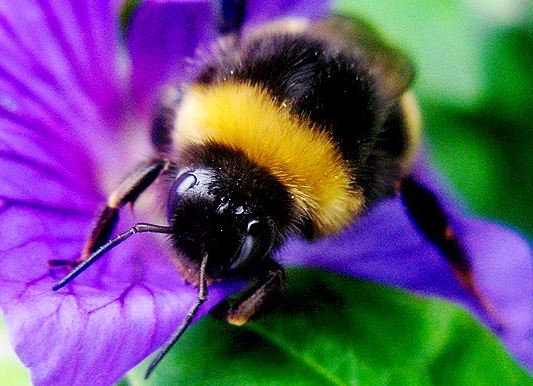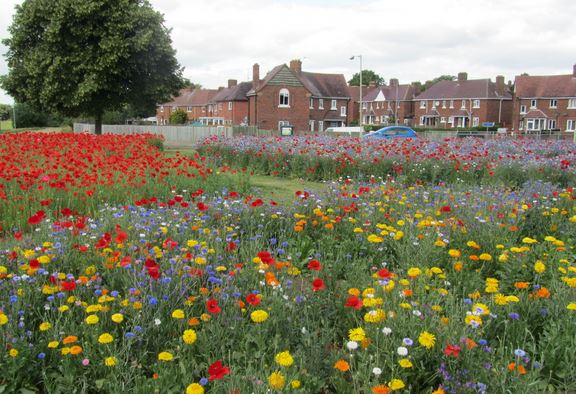Towns and cities are ideal habitats for pollinators like bees, in fact, with such a wide variety of flowering plants in British urban gardens, scientists from the Universities of Bristol, Leeds, Edinburgh, Reading and Cardiff, found bees may fare better than in farmland.
This first study to compare the suitability for different landscapes for pollinating insects across Great Britain has been published in the academic journal Proceedings of the Royal Society B.
Bees are key pollinators in many of the UK’s most important crops. In fact, according to Elizabeth Grossman in an article in Yale e360, one third of all food in the world eaten by humans would not exist if it were not for pollinating insects like bees.

There are many different types of pollinators in British gardens because of their wide variety of flowering plants.
Bee populations globally have been declining at an alarming rate over the past decade, but the effects of urbanization on pollinating insects have not been comprehensively examined.
In this latest study, researchers found that the prevalence of bees did not differ between three different landscapes: 1. Nature reserves. 2. Urban areas. 3. Farmland.
Surprising diversity of bees in urban environments
Bee diversity was found to be greater in towns and cities than in farmland. While hoverfly abundance is higher in nature reserves and farmland that urban areas, overall pollinator diversity was not significantly different, the authors reported.
Study leader, Dr. Katherine Baldock, who works at the University of Bristol’s Cabot Institute and School of Biological Sciences, explained:
“Bees are driven by the availability of food and suitable nesting sites. We found that there were equivalent numbers of bees in the three landscapes studied.”
“In urban areas pollinators foraged on a wide variety of plant species, including many non-native garden plants, but visited a smaller proportion of the available plant species than those in other landscapes. This could be explained by the high diversity of plant species in urban areas.”

Towns and cities play a role in maintaining bee populations.
Dr. Baldock and colleagues compared flower-visiting pollinator communities in 36 urban sites across the UK, and recorded a total of 7,412 insects visiting flowers. They recorded data on 11 rare or scarce species, of which four were also found in urban habitats.
As urban areas continue increasing in size in Britain, their findings have important implications for pollinator conservation, the researchers explained.
They concluded that “urban areas growing and improving their value for pollinators should be part of any national strategy to conserve and restore pollinators.”
Ecology Professor Jane Memmott, who works at the School of Biological Sciences, part of the University of Bristol, added
“Insect pollination has been valued at around £690million per year for UK crop production and many of these urban bees are essential for pollinating some of the fruits and vegetables which are grown in gardens and allotments.”
“These findings offer incentives for policy makers to improve the quality of existing green spaces in urban areas, as urban habitats can contain remarkably high pollinator species richness.”
The Insect Pollinators Initiative is jointly-funded by the Natural Environment Research Council (NERC), Defra, the Biotechnology and Biological Sciences Research Council (BBSRC), the Wellcome Trust, and the Scottish Government.
Stress making bees forage when they are too young
Stresses such as disease and pollution are forcing young bees to go out foraging when they are too young, this is fueling CCD (Colony Collapse Disorder), which is likely to be the main reason for the steep decline in global bee populations, scientists from the UK, US and Australia reported earlier this week.
CCD occurs when the queen and immature bees are still present, but there are no adult or dead bee bodies. It is a serious threat to bee colonies worldwide and affects human food crop pollination.
Citation: “Where is the UK’s pollinator biodiversity? The importance of urban areas for flower-visiting insects,” Katherine C. R. Baldock , Mark A. Goddard , Damien M. Hicks , William E. Kunin , Nadine Mitschunas , Lynne M. Osgathorpe , Simon G. Potts , Kirsty M. Robertson , Anna V. Scott , Graham N. Stone , Ian P. Vaughan , and Jane Memmott. Proceedings of the Royal Society B [Open Access]. Published Feb 11, 2015. DOI: 10.1098/rspb.2014.2849

